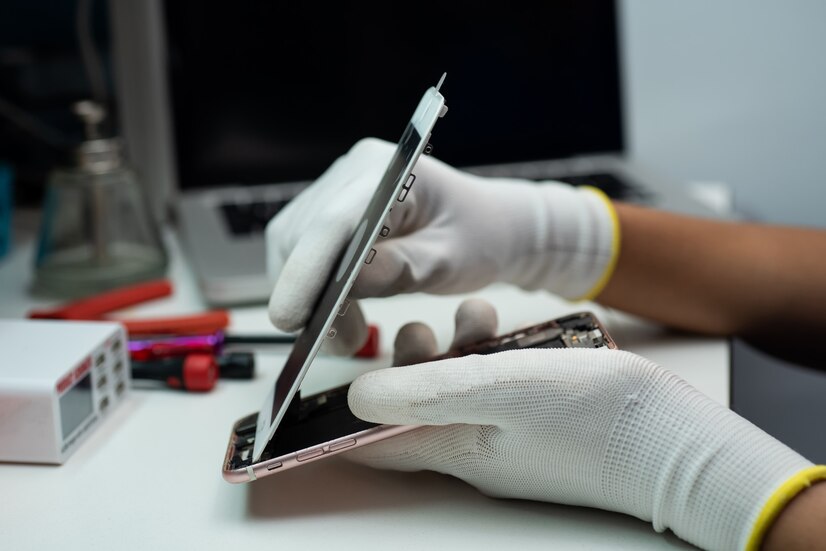In today’s fast-paced world, technology evolves rapidly, and cell phones have become a vital part of our daily lives. However, this convenience comes at a significant environmental cost. With millions of phones being discarded each year, e-waste has become one of the fastest-growing environmental issues. One effective way to combat this problem is by repairing, rather than replacing, our devices. In this article, we’ll explore how Repairing Your Cellphone helps reduce e-waste and plays a vital role in protecting the planet.
What is E-Waste and Why Is It a Problem?
E-waste, short for electronic waste, refers to discarded electronic devices, including phones, computers, and televisions. The environmental impact of e-waste is alarming, as it contains hazardous materials such as lead, mercury, and cadmium, which can leach into the soil and water, causing long-term contamination. E-waste also contributes to air pollution when it is burned to extract valuable metals, releasing toxic fumes into the atmosphere.
The growing issue of e-waste is primarily driven by the rapid pace of technological advancements and the relatively short lifespan of many electronic devices. Cellphones, for example, are often replaced every two years as new models hit the market with upgraded features. This culture of constant upgrading leads to mountains of discarded phones, creating a serious strain on landfills and the environment.
The Environmental Cost of Cellphone Production
Manufacturing a cellphone is an energy-intensive process that requires significant natural resources. From mining rare minerals like lithium, cobalt, and nickel to the extensive energy required in the manufacturing process, the environmental cost of producing a single smartphone is considerable. Studies show that the production of smartphones accounts for a large portion of the carbon footprint associated with their entire lifecycle.
The extraction of these minerals, often from environmentally sensitive areas, can lead to deforestation, habitat destruction, and pollution of local water supplies. Additionally, the vast amount of water used in the production process puts a strain on local resources, especially in regions already facing water scarcity.
The environmental effects of cellphone production are not limited to resource depletion and pollution. The carbon emissions generated during the manufacturing process contribute to global warming, making smartphones a significant player in the climate change crisis.
How Repairing Cell Phones Reduces E-Waste
One of the most effective ways to combat e-waste is by extending the lifespan of our devices through repair. Rather than discarding a damaged phone and purchasing a new one, repairing common issues like cracked screens, battery failure, or software glitches can keep the device functional for years longer.
Repairing a phone prevents it from being thrown away, reducing the volume of electronic waste that ends up in landfills. This approach helps curb the demand for new devices and minimizes the need for the production of new phones, which, as discussed, are resource-intensive and environmentally harmful.
When you repair your phone, you’re making a significant contribution to reducing e-waste. Small repairs such as replacing a screen or a battery can make your phone as good as new, eliminating the need for a costly and environmentally harmful replacement.
If you’re unsure where to get your phone repaired, Check out Cell Mechanics for iPhone and Samsung repair, a service that specializes in bringing devices back to life. Start your journey toward a greener, more sustainable future today.
The Benefits of Repairing Phones for the Environment
By choosing to repair rather than replace your phone, you help reduce the demand for new resources. Each repair saves precious materials, such as rare metals and plastics, from being used in the production of a new device. This not only conserves natural resources but also reduces the energy and water consumption associated with manufacturing new phones.
Additionally, Repairing Your Cellphone helps to minimize the growing issue of e-waste. Instead of your old phone contributing to landfill overflow, it is given a second life through repair, keeping it out of the waste stream. This is especially important because many of the materials found in phones, such as batteries, are hazardous and can leak toxins into the environment if not disposed of properly.
Repairing Your Cellphone also supports the concept of a circular economy. A circular economy emphasizes reusing, recycling, and repairing products rather than following the traditional “take-make-dispose” model. By keeping devices in use for longer, we can create a more sustainable and responsible technology industry.
The Role of Consumers in Reducing E-Waste
While manufacturers and policymakers play a crucial role in tackling the issue of e-waste, consumers also have the power to make a significant impact. By making informed decisions about their devices, consumers can contribute to reducing e-waste and encouraging sustainable practices.
Choosing to repair a phone rather than replace it sends a strong message to manufacturers that consumers value longevity over obsolescence. Supporting repair services that focus on sustainability can also help drive demand for eco-friendly repair solutions, pushing the industry toward more responsible practices.
Furthermore, by adopting a mindset of repair over replacement, consumers can encourage a cultural shift away from the disposable mentality that currently dominates the technology sector. Repairing Your Cellphone, rather than upgrading to the latest model, is one of the simplest ways to reduce your environmental footprint.
How Repair Services Are Evolving
The repair industry itself has also evolved, with more businesses focusing on sustainability and eco-friendly practices. Many repair shops now offer services that prioritize the reuse of parts and components, reducing the need for new materials. Some even go a step further by recycling old parts and ensuring that they don’t contribute to e-waste.
Online repair services are also making it easier than ever to get your phone repaired, whether through mail-in options or home service calls. These services often use sustainable practices, such as recycling parts and reducing waste in their repair processes.
The rise of these services reflects a growing recognition of the need for more sustainable electronics practices. As more consumers demand repair-friendly options, the repair industry is adapting, making it easier to extend the life of devices and reduce their environmental impact.
Conclusion
Repairing Your Cellphone is one of the most effective ways to reduce e-waste and contribute to a more sustainable future. By choosing to repair your phone instead of replacing it, you help conserve valuable resources, reduce carbon emissions, and prevent harmful materials from polluting the environment.
The power to reduce e-waste lies in our hands. As consumers, we can make a difference by supporting repair services, choosing longevity over the latest trend, and encouraging a shift toward a circular economy. Every small action counts, and together, we can make a significant impact on the health of our planet.
So, the next time your phone breaks or starts to show signs of wear, consider repairing it instead of replacing it. By doing so, you’ll not only save money, but you’ll also be making a positive contribution to the environment.







